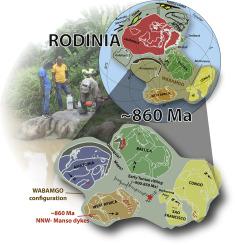Gondwana Research ( IF 6.1 ) Pub Date : 2021-03-05 , DOI: 10.1016/j.gr.2021.02.010 Paul Yves Jean Antonio , Lenka Baratoux , Ricardo Ivan Ferreira Trindade , Sonia Rousse , Anani Ayite , Cristiano Lana , Mélina Macouin , Emmanuel Williams Kobby Adu , Caroline Sanchez , Marco Antônio Leandro Silva , Anne-Sophie Firmin , Carmen Irène Martinez Dopico , Arnaud Proietti , Prince Ofori Amponsah , Patrick Asamoah Sakyi

|
The paleogeography of the Meso-Neoproterozoic Rodinia supercontinent remains debated partly because many stable cratons still lack reliable paleomagnetic data for this period. A new geochronological and paleomagnetic study was conducted on the NNW-trending Manso dyke swarm of southern West Africa (Ghana) to clarify the position of this unconstrained continent in Rodinia. Two U Pb apatite ages of 857.2 ± 8.5 Ma and 855 ± 16 Ma agree with one previous baddeleyite age, indicating a ~ 860 Ma emplacement age for the Manso dykes. A characteristic remanent magnetization (ChRM) was isolated in stable single to pseudo-single domain (SD-PSD) magnetite. Well constrained site mean directions obtained for 13 dykes lead to a mean direction for the Manso dyke swarm of Dm = 181.9°, Im = −77.2° (N = 13, α95 = 7.6°, k = 30.6), yielding a paleomagnetic pole at 177.6°E, 28.3°S, (A95 = 12.7 °K = 11.6). Two directional clusters of opposite inclination pass a reversal test (C-class) and the primary origin is supported by a positive baked contact test, satisfying all the seven R-criteria to provide the first West African Tonian key paleomagnetic pole. This key pole indicates a high latitude for the West Africa Craton during the emplacement of the ~860 Manso dykes. A compilation of reliable paleomagnetic poles for West Africa, Baltica, Amazonia and Congo-São Francisco cratons suggests that these cratons were together between ~1200 and 800 Ma in a long-lived WABAMGO configuration. We suggest that the collision of this block with Laurentia along the Grenvillian-Sunsás orogens closed the external Nuna Ocean and formed Rodinia by extroversion.
Pb apatite ages of 857.2 ± 8.5 Ma and 855 ± 16 Ma agree with one previous baddeleyite age, indicating a ~ 860 Ma emplacement age for the Manso dykes. A characteristic remanent magnetization (ChRM) was isolated in stable single to pseudo-single domain (SD-PSD) magnetite. Well constrained site mean directions obtained for 13 dykes lead to a mean direction for the Manso dyke swarm of Dm = 181.9°, Im = −77.2° (N = 13, α95 = 7.6°, k = 30.6), yielding a paleomagnetic pole at 177.6°E, 28.3°S, (A95 = 12.7 °K = 11.6). Two directional clusters of opposite inclination pass a reversal test (C-class) and the primary origin is supported by a positive baked contact test, satisfying all the seven R-criteria to provide the first West African Tonian key paleomagnetic pole. This key pole indicates a high latitude for the West Africa Craton during the emplacement of the ~860 Manso dykes. A compilation of reliable paleomagnetic poles for West Africa, Baltica, Amazonia and Congo-São Francisco cratons suggests that these cratons were together between ~1200 and 800 Ma in a long-lived WABAMGO configuration. We suggest that the collision of this block with Laurentia along the Grenvillian-Sunsás orogens closed the external Nuna Ocean and formed Rodinia by extroversion.
中文翻译:

罗丹尼亚的西非:来自〜860 Ma Manso堤防群(加纳)的高质量古地磁极
中新元古代罗迪尼亚超大陆的古地理学仍存在争议,部分原因是在此期间许多稳定的克拉通仍缺乏可靠的古磁数据。对西非南部(加纳)NNW趋势Manso堤防群进行了一项新的年代学和古地磁研究,以阐明这一不受限制的大陆在罗迪尼亚的位置。两个U  Pb磷灰石年龄分别为857.2±8.5 Ma和855±16 Ma,与先前的一个大晶石年龄一致,表明曼索堤坝的沉积年龄为〜860 Ma。在稳定的单至伪单畴(SD-PSD)磁铁矿中隔离了特征性剩磁(ChRM)。获得了13个堤防的受约束位置的平均方向导致了Manso堤防群的平均方向D m = 181.9°,I m = -77.2°(Ñ = 13,α 95 = 7.6°,K = 30.6),产生在177.6°E,28.3°S,(A一古地磁极95 = 12.7°K = 11.6)。两个相反倾角的定向簇通过了逆转测试(C级),并且正向烘烤接触测试支持了主要原点,满足了所有七个R标准,从而提供了第一个西非Tonian关键古磁极。这个关键极点表明,在〜860年曼索堤防进驻期间,西非克拉通具有较高的纬度。西非,波罗的海,亚马逊河和刚果-圣弗朗西斯科克拉通的可靠古地磁极的汇编表明,在长期存在的WABAMGO配置中,这些克拉通的总重在1200至800 Ma之间。我们建议,该区块与Laurentia沿Grenvillian-Sunsás造山带的碰撞封闭了外部的努纳海洋,并通过外向性形成了罗迪尼亚。
Pb磷灰石年龄分别为857.2±8.5 Ma和855±16 Ma,与先前的一个大晶石年龄一致,表明曼索堤坝的沉积年龄为〜860 Ma。在稳定的单至伪单畴(SD-PSD)磁铁矿中隔离了特征性剩磁(ChRM)。获得了13个堤防的受约束位置的平均方向导致了Manso堤防群的平均方向D m = 181.9°,I m = -77.2°(Ñ = 13,α 95 = 7.6°,K = 30.6),产生在177.6°E,28.3°S,(A一古地磁极95 = 12.7°K = 11.6)。两个相反倾角的定向簇通过了逆转测试(C级),并且正向烘烤接触测试支持了主要原点,满足了所有七个R标准,从而提供了第一个西非Tonian关键古磁极。这个关键极点表明,在〜860年曼索堤防进驻期间,西非克拉通具有较高的纬度。西非,波罗的海,亚马逊河和刚果-圣弗朗西斯科克拉通的可靠古地磁极的汇编表明,在长期存在的WABAMGO配置中,这些克拉通的总重在1200至800 Ma之间。我们建议,该区块与Laurentia沿Grenvillian-Sunsás造山带的碰撞封闭了外部的努纳海洋,并通过外向性形成了罗迪尼亚。


























 京公网安备 11010802027423号
京公网安备 11010802027423号